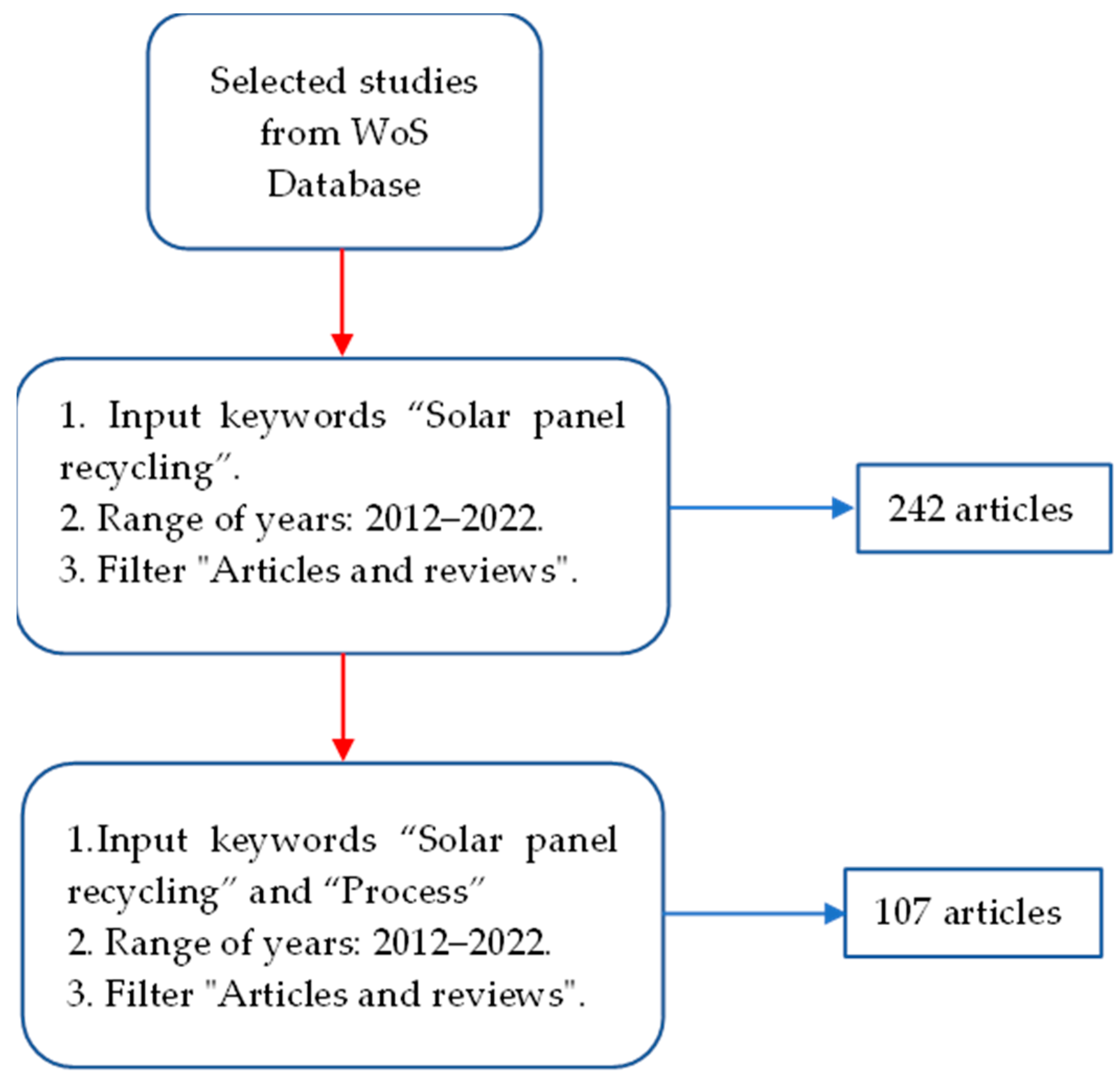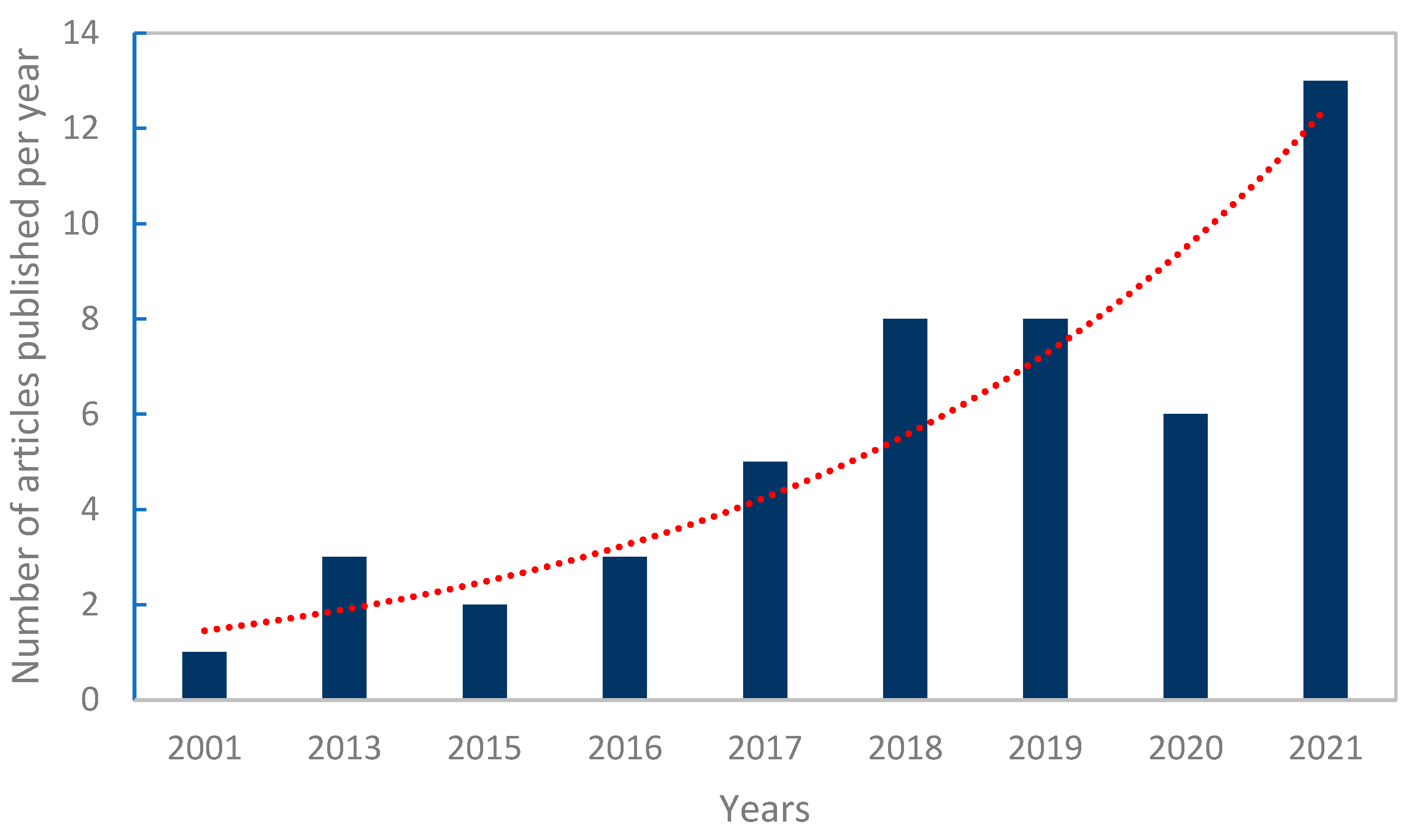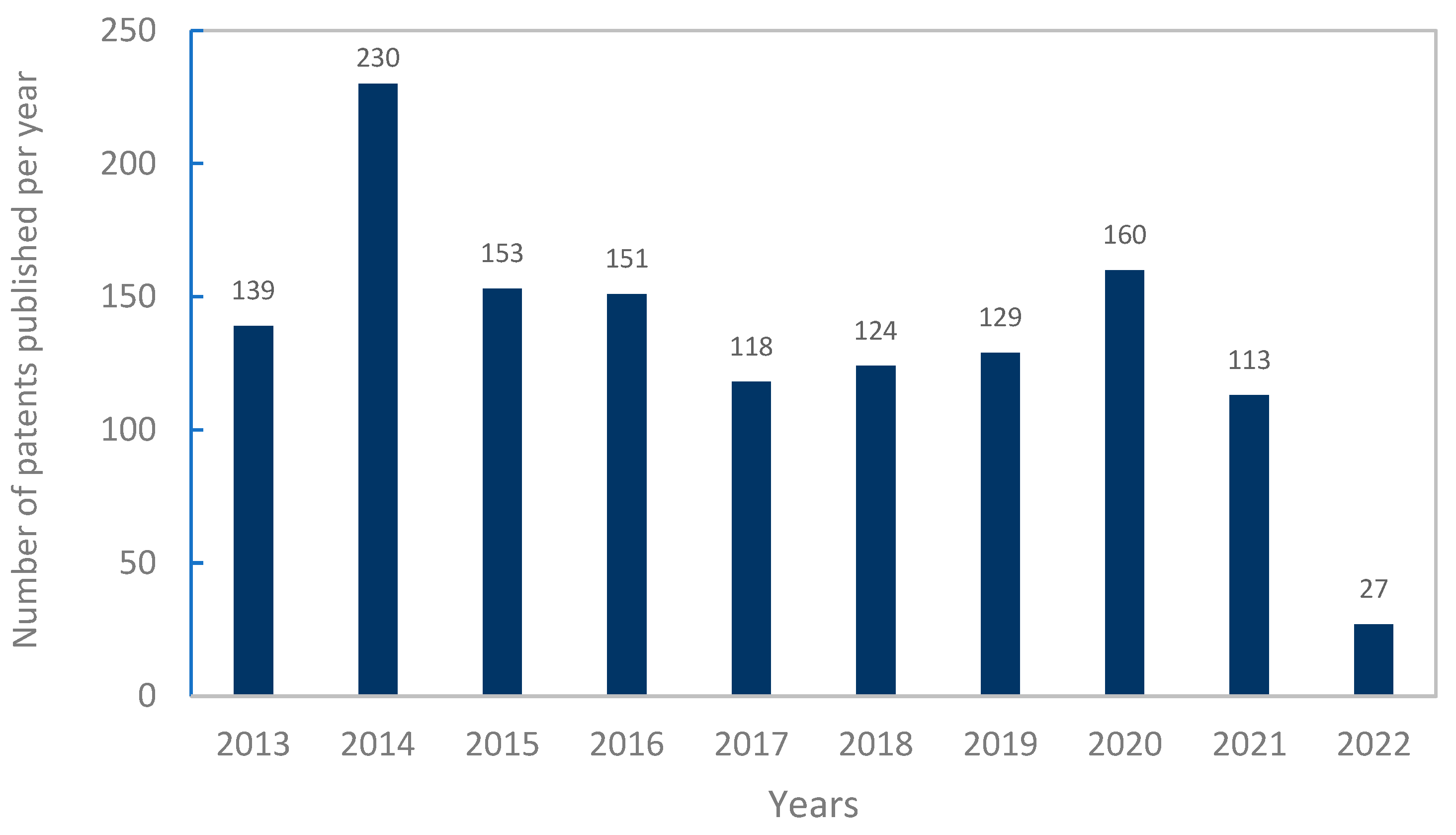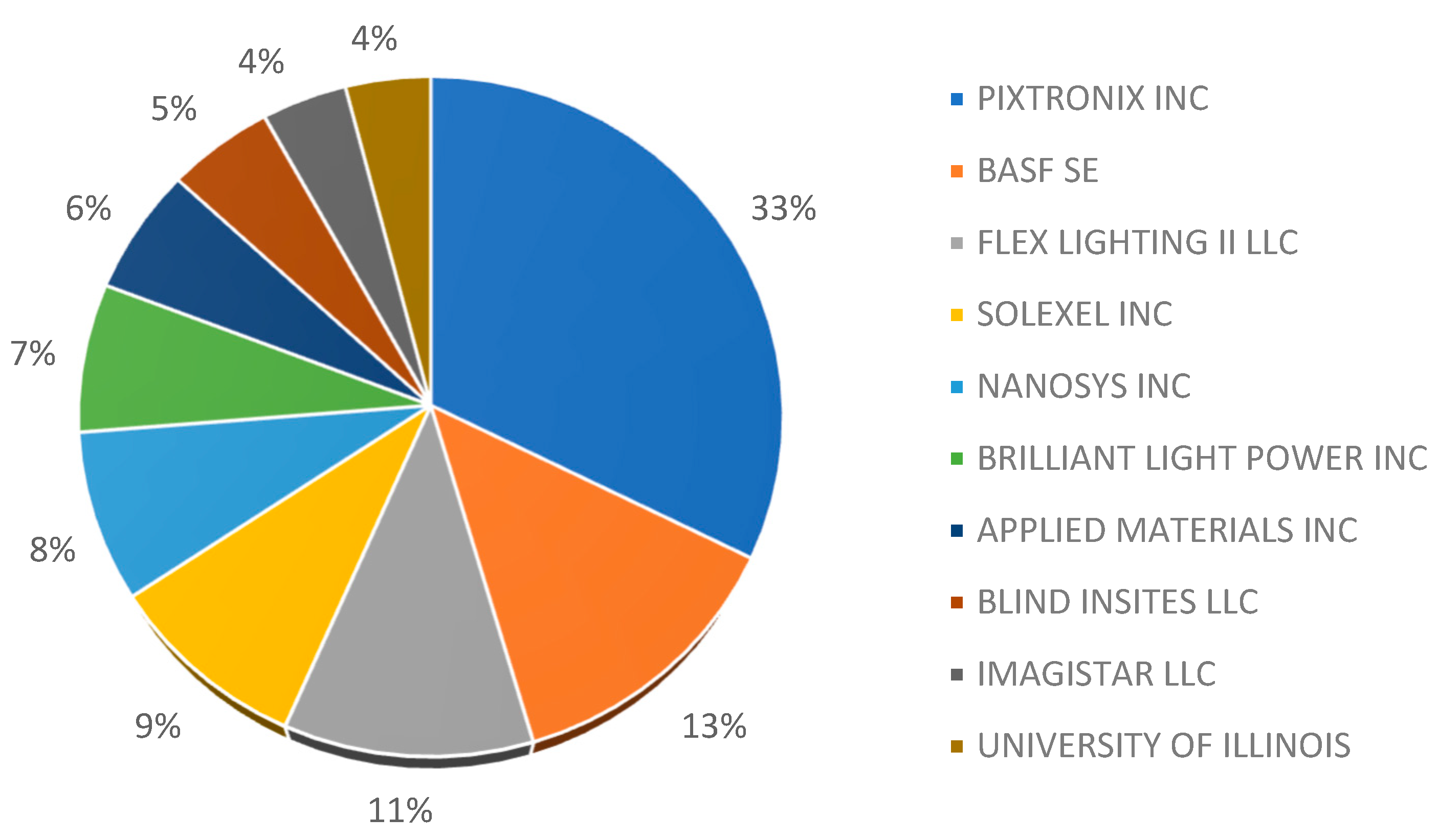Technological Advancement in Solar Photovoltaic Recycling: A Review
Abstract
:1. Introduction
2. Methodology
- The identification of studies in the database: The search for studies was performed in the Web of Science (WoS) database in December of 2021 using the keywords “solar panel recycling” as presented in Figure 1. The management of these articles was performed through the Mendeley software (2.74.0) to eliminate duplicate articles and multiple studies by the same author.
- Narrowing the search: the second screening of articles was performed using “solar panel”, “recycling”, and “process” as key words. The screening of the studies was analyzed considering articles that contain details on the processes involved during the recycling of solar panels
- The primary review of studies: All identified studies were initially reviewed by an examination of their titles, abstracts, and keywords to discard studies that did not fit the topic of analysis.
- Study reading: The selected studies were read in full. This step was taken to discard studies that were not written in English and articles with restricted access.
3. Results and Discussion
3.1. Distribution of Articles and Patents on Photovoltaic Panels Recycling
3.2. Studies on Methods of Recycling
3.2.1. Mechanical Treatment
3.2.2. Chemical Treatment
3.2.3. Thermal Treatment
3.3. Patents on Recycling Methods
4. Industrial Application Analysis
5. Challenges in the Recycling of Photovoltaic Panels
6. Conclusions
Author Contributions
Funding
Acknowledgments
Conflicts of Interest
Abbreviations
| PV | Photovoltaic panels |
| WEEE | Waste Electrical and Electronic Equipment |
| IRENA | International Renewable Energy Agency |
| REP | Extended Producer Responsibility |
| IEA | International Energy Agency |
| EVA | Ethylene vinyl acetate |
| EU | European Union |
References
- The International Energy Agency. Energy Technology Perspectives 2015 Mobilising Innovation to Accelerate Climate Action. Available online: http://www.iea.org/t&c/ (accessed on 21 May 2024).
- Louwen, A.; van Sark, W.; Schropp, R.; Turkenburg, W.; Faaij, A. Life-cycle greenhouse gas emissions and energy payback time of current and prospective silicon heterojunction solar cell designs. Prog. Photovolt. Res. Appl. 2015, 23, 1406–1428. [Google Scholar] [CrossRef]
- International Renewable Energy Agency. Renewable Energy Statistics 2023 Statistiques D’énergie Renouvelable 2023 Estadísticas de Energía Renovable 2023 about IRENA. 2023. Available online: www.irena.org (accessed on 13 June 2024).
- Jain, A.; Bhullar, S. Operating modes of grid integrated PV-solar based electric vehicle charging system—A comprehensive review. Adv. Electr. Eng. Electron. Energy 2024, 8, 100519. [Google Scholar] [CrossRef]
- Chacón-Ortiz, A.; Da Maia, L.C.; de Oliveira, A.C.; Pegoraro, C. Climate-smart agriculture. utopia or reality? Rev. Acta Ambient. Catarin. 2021, 19, 1–20. [Google Scholar] [CrossRef]
- Boletín Generadoras de Chile—Diciembre 2023. Available online: https://generadoras.cl/documentos/boletines/boletin-generadoras-de-chile-diciembre-2023 (accessed on 19 June 2024).
- Sah, D.; Chitra; Lodhi, K.; Kant, C.; Srivastava, S.K.; Kumar, S. Extraction and Analysis of Recovered Silver and Silicon from Laboratory Grade Waste Solar Cells. Silicon 2022, 14, 9635–9642. [Google Scholar] [CrossRef]
- Pagnanelli, F.; Moscardini, E.; Granata, G.; Atia, T.A.; Altimari, P.; Havlik, T.; Toro, L. Physical and chemical treatment of end of life panels: An integrated automatic approach viable for different photovoltaic technologies. Waste Manag. 2017, 59, 422–431. [Google Scholar] [CrossRef] [PubMed]
- Belsky, A.; Glukhanich, D.; Carrizosa, M.; Starshaia, V. Analysis of specifications of solar photovoltaic panels. Renew. Sustain. Energy Rev. 2022, 159, 112239. [Google Scholar] [CrossRef]
- Maridevaru, M.C.; Ashokkumar, M.; Renganathan, R.; Anandan, S. Review on Characteristics, Scalable Fabrication, Advancing Strategies, and Recent Enhancements in High-Performance Perovskite Photovoltaic Cells. In Reference Module in Earth Systems and Environmental Sciences; Elsevier: Amsterdam, The Netherlands, 2024. [Google Scholar] [CrossRef]
- Marwede, M.; Berger, W.; Schlummer, M.; Mäurer, A.; Reller, A. Recycling paths for thin-film chalcogenide photovoltaic waste—Current feasible processes. Renew. Energy 2013, 55, 220–229. [Google Scholar] [CrossRef]
- Kuroiwa, K.; Ohura, S.-I.; Morisada, S.; Ohto, K.; Kawakita, H.; Matsuo, Y.; Fukuda, D. Recovery of germanium from waste solar panels using ion-exchange membrane and solvent extraction. Miner. Eng. 2014, 55, 181–185. [Google Scholar] [CrossRef]
- Park, S.Y.; Park, J.-S.; Kim, B.J.; Lee, H.; Walsh, A.; Zhu, K.; Kim, D.H.; Jung, H.S. Sustainable lead management in halide perovskite solar cells. Nat. Sustain. 2020, 3, 1044–1051. [Google Scholar] [CrossRef]
- Le Khac, D.; Chowdhury, S.; Najm, A.S.; Luengchavanon, M.; Holi, A.M.; Jamal, M.S.; Chia, C.H.; Techato, K.; Selvanathan, V. Efficient laboratory perovskite solar cell recycling with a one-step chemical treatment and recovery of ITO-coated glass substrates. Sol. Energy 2024, 267, 112214. [Google Scholar] [CrossRef]
- Fuentealba, E.; Ferrada, P.; Araya, F.; Marzo, A.; Parrado, C.; Portillo, C. Photovoltaic performance and LCoE comparison at the coastal zone of the Atacama Desert, Chile. Energy Convers. Manag. 2015, 95, 181–186. [Google Scholar] [CrossRef]
- Ferrada, P.; Marzo, A.; Cabrera, E.; Chu, H.; del Campo, V.; Rabanal, J.; Diaz-Almeida, D.; Schneider, A.; Kopecek, R. Potential for photogenerated current for silicon based photovoltaic modules in the Atacama Desert. Sol. Energy 2017, 144, 580–593. [Google Scholar] [CrossRef]
- Komoto, K.; Lee, J.-S.; Zhang, J.; Ravikumar, D.; Sinha, P.; Wade, A.; A Heath, G. End-of-Life Management of Photovoltaic Panels: Trends in PV Module Recycling Technologies; National Renewable Energy Lab. (NREL): Golden, CO, USA, 2018. [Google Scholar] [CrossRef]
- Mehmood, M.U.; Ulasyar, A.; Ali, W.; Zeb, K.; Zad, H.S.; Uddin, W.; Kim, H.-J. A New Cloud-Based IoT Solution for Soiling Ratio Measurement of PV Systems Using Artificial Neural Network. Energies 2023, 16, 996. [Google Scholar] [CrossRef]
- Lucchi, E.; Dall’Orto, I.; Peluchetti, A.; Toledo, L.; Pelle, M.; López, C.P.; Guazzi, G. Photovoltaic technologies in historic buildings and protected areas: Comprehensive legislative framework in Italy and Switzerland. Energy Policy 2022, 161, 112772. [Google Scholar] [CrossRef]
- Guerin, T.F. Impacts and opportunities from large-scale solar photovoltaic (PV) electricity generation on agricultural production. Environ. Qual. Manag. 2019, 28, 7–14. [Google Scholar] [CrossRef]
- Lucchi, E.; Polo Lopez, C.S.; Franco, G. A conceptual framework on the integration of solar energy systems in heritage sites and buildings. IOP Conf. Ser. Mater. Sci. Eng. 2020, 949, 012113. [Google Scholar] [CrossRef]
- Jain, S.; Sharma, T.; Gupta, A.K. End-of-life management of solar PV waste in India: Situation analysis and proposed policy framework. Renew. Sustain. Energy Rev. 2022, 153, 111774. [Google Scholar] [CrossRef]
- El-Khawad, L.; Bartkowiak, D.; Kümmerer, K. Improving the end-of-life management of solar panels in Germany. Renew. Sustain. Energy Rev. 2022, 168, 112678. [Google Scholar] [CrossRef]
- Lee, S.-H.; Jang, Y.-C. Analysis for End-of-Life Solar Panel Generations by Renewable Energy Supply towards Carbon Neutrality in South Korea. Energies 2023, 16, 8039. [Google Scholar] [CrossRef]
- Moraga Sariego, P. Ley Marco para la Gestión de Residuos, la Responsabilidad Extendida del Productor y Fomento al Reciclaje Ley No 20.920. Actual. Jurídica Ambient. 2016, 25–27, ISSN-e 1989-5666. Available online: https://dialnet.unirioja.es/servlet/articulo?codigo=5710963 (accessed on 21 May 2024).
- Ndzibah, E.; La Cruz, G.A.P.-D.; Shamsuzzoha, A. Collaboration towards value creation for end-of-life solar photovoltaic panel in Ghana. J. Clean. Prod. 2022, 333, 129969. [Google Scholar] [CrossRef]
- Moher, D.; Liberati, A.; Tetzlaff, J.; Altman, D.G. Preferred reporting items for systematic reviews and meta-analyses: The PRISMA statement. Int. J. Surg. 2010, 8, 336–341. [Google Scholar] [CrossRef] [PubMed]
- Rebolledo-Leiva, R.; Moreira, M.T.; González-García, S. Progress of social assessment in the framework of bioeconomy under a life cycle perspective. Renew. Sustain. Energy Rev. 2023, 175, 113162. [Google Scholar] [CrossRef]
- Instituto Nacional de Propiedad Industrial (INAPI). Centros de Documentación—Informes. Available online: https://www.inapi.cl/centro-de-documentacion/informes (accessed on 2 June 2024).
- Pablo, R.D.; Suvi, S. Solar Module Recycling and Testing. 2023. Available online: https://worldwide.espacenet.com/patent/search/family/088420732/publication/WO2023205732A1?q=pn%3DWO2023205732A1 (accessed on 2 June 2024).
- SolarCycle. Available online: https://www.solarcycle.us/about (accessed on 2 June 2024).
- Unión Española Fotovoltaica. Análisis del Estado del Arte del Reciclaje de Paneles Fotovoltaicos. 2020. Available online: https://www.unef.es/es/descargar-documento/cf017acb44f537ef5e9773965c21a610 (accessed on 19 June 2024).
- Photovoltaic Modules Recycling|ROSI. Available online: https://www.rosi-solar.com/photovoltaic-modules-recycling/ (accessed on 13 June 2024).
- Solar Panel Recycling Service|NPC Incorporated. Available online: https://www.npcgroup.net/eng/solarpower/reuse-recycle/recycle-service (accessed on 13 June 2024).
- First Solar. Sustainability Report; First Solar: Tempe, AZ, USA, 2017. [Google Scholar]
- Padoan, F.C.; Altimari, P.; Pagnanelli, F. Recycling of end of life photovoltaic panels: A chemical prospective on process development. Sol. Energy 2019, 177, 746–761. [Google Scholar] [CrossRef]
- Santoyo-Castelazo, E.; Solano-Olivares, K.; Martínez, E.; García, E.; Santoyo, E. Life cycle assessment for a grid-connected multi-crystalline silicon photovoltaic system of 3 kWp: A case study for Mexico. J. Clean. Prod. 2021, 316, 128314. [Google Scholar] [CrossRef]
- Ziemińska-Stolarska, A.; Pietrzak, M.; Zbiciński, I. Effect of Recycling on the Environmental Impact of a High-Efficiency Photovoltaic Module Combining Space-Grade Solar Cells and Optical Micro-Tracking. Energies 2023, 16, 3302. [Google Scholar] [CrossRef]
- Agustín-Sáenz, C.; Machado, M.; Zubillaga, O.; Tercjak, A. Hydrophobic and spectrally broadband antireflective methyl-silylated silica coatings with high performance stability for concentrated solar applications. Sol. Energy Mater. Sol. Cells 2019, 200, 109962. [Google Scholar] [CrossRef]
- Nayeripour, M. Solar Cells. Available online: https://books.google.com/books/about/Solar_Cells.html?hl=es&id=Q0P8DwAAQBAJ (accessed on 21 May 2024).
- Weckend, S.; Wade, A.; Heath, G.A. End of Life Management: Solar Photovoltaic Panels; National Renewable Energy Lab. (NREL): Golden, CO, USA, 2016. [Google Scholar] [CrossRef]
- Corcelli, F.; Ripa, M.; Ulgiati, S. End-of-life treatment of crystalline silicon photovoltaic panels. An energy-based case study. J. Clean. Prod. 2017, 161, 1129–1142. [Google Scholar] [CrossRef]
- Corcelli, F.; Ripa, M.; Leccisi, E.; Cigolotti, V.; Fiandra, V.; Graditi, G.; Sannino, L.; Tammaro, M.; Ulgiati, S. Sustainable urban electricity supply chain—Indicators of material recovery and energy savings from crystalline silicon photovoltaic panels end-of-life. Ecol. Indic. 2018, 94, 37–51. [Google Scholar] [CrossRef]
- Lim, M.S.W.; He, D.; Tiong, J.S.M.; Hanson, S.; Yang, T.C.-K.; Tiong, T.J.; Pan, G.-T.; Chong, S. Experimental, economic and life cycle assessments of recycling end-of-life monocrystalline silicon photovoltaic modules. J. Clean. Prod. 2022, 340, 130796. [Google Scholar] [CrossRef]
- Abdo, D.M.; Mangialardi, T.; Medici, F.; Piga, L. D-Limonene as a Promising Green Solvent for the Detachment of End-of-Life Photovoltaic Solar Panels under Sonication. Processes 2023, 11, 1848. [Google Scholar] [CrossRef]
- Zaidi, A.; Barambones, O.; Zanzouri, N. Implementation of a Cascade Fault Tolerant Control and Fault Diagnosis Design for a Modular Power Supply. Actuators 2023, 12, 135. [Google Scholar] [CrossRef]
- Nevala, S.-M.; Hamuyuni, J.; Junnila, T.; Sirviö, T.; Eisert, S.; Wilson, B.P.; Serna-Guerrero, R.; Lundström, M. Electro-hydraulic fragmentation vs conventional crushing of photovoltaic panels—Impact on recycling. Waste Manag. 2019, 87, 43–50. [Google Scholar] [CrossRef] [PubMed]
- Song, B.-P.; Zhang, M.-Y.; Fan, Y.; Jiang, L.; Kang, J.; Gou, T.-T.; Zhang, C.-L.; Yang, N.; Zhang, G.-J.; Zhou, X. Recycling experimental investigation on end of life photovoltaic panels by application of high voltage fragmentation. Waste Manag. 2020, 101, 180–187. [Google Scholar] [CrossRef] [PubMed]
- Li, X.; Liu, H.; You, J.; Diao, H.; Zhao, L.; Wang, W. Back EVA recycling from c-Si photovoltaic module without damaging solar cell via laser irradiation followed by mechanical peeling. Waste Manag. 2022, 137, 312–318. [Google Scholar] [CrossRef] [PubMed]
- Lovato, É.S.; Donato, L.M.; Lopes, P.P.; Tanabe, E.H.; Bertuol, D.A. Application of supercritical CO2 for delaminating photovoltaic panels to recover valuable materials. J. CO2 Util. 2021, 46, 101477. [Google Scholar] [CrossRef]
- Shin, J.; Park, J.; Park, N. A method to recycle silicon wafer from end-of-life photovoltaic module and solar panels by using recycled silicon wafers. Sol. Energy Mater. Sol. Cells 2017, 162, 1–6. [Google Scholar] [CrossRef]
- Kang, S.; Yoo, S.; Lee, J.; Boo, B.; Ryu, H. Experimental investigations for recycling of silicon and glass from waste photovoltaic modules. Renew. Energy 2012, 47, 152–159. [Google Scholar] [CrossRef]
- Kavousi, M.; Alamdari, E.K. A Comprehensive and Sustainable Recycling Process for Different Types of Blended End-of-Life Solar Panels: Leaching and Recovery of Valuable Base and Precious Metals and/or Elements. Metals 2023, 13, 1677. [Google Scholar] [CrossRef]
- Abdo, D.M.; El-Shazly, A.N.; Medici, F. Recovery of Valuable Materials from End-of-Life Photovoltaic Solar Panels. Materials 2023, 16, 2840. [Google Scholar] [CrossRef]
- Dias, P.R.; Benevit, M.G.; Veit, H.M. Photovoltaic solar panels of crystalline silicon: Characterization and separation. Waste Manag. Res. 2016, 34, 235–245. [Google Scholar] [CrossRef]
- Chiang, P.F.; Han, S.; Claire, M.J.; Maurice, N.J.; Vakili, M.; Giwa, A.S. Sustainable Treatment of Spent Photovoltaic Solar Panels Using Plasma Pyrolysis Technology and Its Economic Significance. Clean Technol. 2024, 6, 432–452. [Google Scholar] [CrossRef]
- Lee, C.-H.; Hung, C.-E.; Tsai, S.-L.; Popuri, S.R.; Liao, C.-H. Resource recovery of scrap silicon solar battery cell. Waste Manag. Res. 2013, 31, 518–524. [Google Scholar] [CrossRef] [PubMed]
- Frisson, L.; Lieten, K.; Bruton, T.; Declercq, K.; Szlufcik, J.; de Moor, H.; Gorts, M.; Benali, A.; Aceves, O. Recent Improvements in Industrial PV Module Recycling. In Proceedings of the 16th European Photovoltaic Solar Energy Conference, Glasgow, UK, 1–5 May 2000; pp. 2160–2163. [Google Scholar]
- Song, Q.; Zhang, L.; Yang, C.; Xu, Z. Novel Electrodeposition Method for Cu-In-Cd-Ga Sequential Separation from Waste Solar Cell: Mechanism, Application, and Environmental Impact Assessment. Environ. Sci. Technol. 2021, 55, 10724–10733. [Google Scholar] [CrossRef] [PubMed]
- Kokul, S.R.; Bhowmik, S. Recycling of crystalline silicon photovoltaic solar panel waste to modified composite products. Prog. Rubber Plast. Recycl. Technol. 2021, 37, 327–339. [Google Scholar] [CrossRef]
- Tokoro, C.; Nishi, M.; Tsunazawa, Y. Selective grinding of glass to remove resin for silicon-based photovoltaic panel recycling. Adv. Powder Technol. 2021, 32, 841–849. [Google Scholar] [CrossRef]
- Riech, I.; Castro-Montalvo, C.; Wittersheim, L.; Giácoman-Vallejos, G.; González-Sánchez, A.; Gamboa-Loira, C.; Acosta, M.; Méndez-Gamboa, J. Experimental Methodology for the Separation Materials in the Recycling Process of Silicon Photovoltaic Panels. Materials 2021, 14, 581. [Google Scholar] [CrossRef] [PubMed]
- Huang, W.-H.; Shin, W.J.; Wang, L.; Sun, W.-C.; Tao, M. Strategy and technology to recycle wafer-silicon solar modules. Sol. Energy 2017, 144, 22–31. [Google Scholar] [CrossRef]
- Liu, F.-W.; Cheng, T.-M.; Chen, Y.-J.; Yueh, K.-C.; Tang, S.-Y.; Wang, K.; Wu, C.-L.; Tsai, H.-S.; Yu, Y.-J.; Lai, C.-H.; et al. High-yield recycling and recovery of copper, indium, and gallium from waste copper indium gallium selenide thin-film solar panels. Sol. Energy Mater. Sol. Cells 2022, 241, 111691. [Google Scholar] [CrossRef]
- Jung, B.; Park, J.; Seo, D.; Park, N. Sustainable System for Raw-Metal Recovery from Crystalline Silicon Solar Panels: From Noble-Metal Extraction to Lead Removal. ACS Sustain. Chem. Eng. 2016, 4, 4079–4083. [Google Scholar] [CrossRef]
- Pasin, A. A Method and Machine to Assist Recycling of Photovoltaic Panels. WO2013057035A1, 11 October 2012. [Google Scholar]
- Wang, S.; Wang, Z.; Zhou, H.; He, S.; Hou, C. Method and Device for Decomposing and Recycling Photovoltaic Component. CN102544239B, 7 March 2012. [Google Scholar]
- Li, X. Photovoltaic Module Recycling Method and System. CN110571306B, 12 September 2019. [Google Scholar]
- Zambon, A.; Cerchier, P. Method and Plant for Recycling Photovoltaic Panels. WO2019087111A1, 31 October 2018. [Google Scholar]
- Schrijnemakers, A.; Boschini, F.; Cloots, R. Method for Recycling Photovoltaic Solar Cells Module. WO2017009062A1, 1 July 2016. [Google Scholar]
- Wang, H.; Oguz, E.; Jeong, B.; Zhou, P. Life cycle and economic assessment of a solar panel array applied to a short route ferry. J. Clean. Prod. 2019, 219, 471–484. [Google Scholar] [CrossRef]
- Farjana, S.H.; Mungombe, T.M.; Gamage, H.M.K.; Rajwani, A.S.; Tokede, O.; Ashraf, M. Circulating the E-Waste Recovery from the Construction and Demolition Industries: A Review. Sustainability 2023, 15, 12435. [Google Scholar] [CrossRef]
- Homepage|Veolia. Available online: https://www.veolia.com/latamib/es (accessed on 21 May 2024).
- ROSI|Return of Silicon. Available online: https://www.rosi-solar.com/ (accessed on 12 July 2022).
- Recyclables Management. Recycling.|Reiling Unternehmensgruppe. Available online: https://www.reiling.de/en (accessed on 21 May 2024).
- Palitzsch, W.; Loser, U. Economic PV waste recycling solutions—Results from R&D and practice. In Proceedings of the 2012 38th IEEE Photovoltaic Specialists Conference, Austin, TX, USA, 3–8 June 2012; pp. 628–631. [Google Scholar]
- Riciclaggio Pannelli Fotovoltaici—Compton Industriale. Available online: https://www.compton-industriale.it/riciclaggio-pannelli-fotovoltaici-.html (accessed on 21 May 2024).
- NPC Incorporated|Global Leader of Solar Module Manufacturing Equipment. Available online: https://www.npcgroup.net/eng/ (accessed on 21 May 2024).
- Ghahremani, A.; Adams, S.D.; Norton, M.; Khoo, S.Y.; Kouzani, A.Z. Delamination Techniques of Waste Solar Panels: A Review. Clean Technol. 2024, 6, 280–298. [Google Scholar] [CrossRef]
- Nain, P.; Kumar, A. A state-of-art review on end-of-life solar photovoltaics. J. Clean. Prod. 2022, 343, 130978. [Google Scholar] [CrossRef]
- Isherwood, P.J.M. Reshaping the Module: The Path to Comprehensive Photovoltaic Panel Recycling. Sustainability 2022, 14, 1676. [Google Scholar] [CrossRef]





| Country | Number of Articles | Percentage |
|---|---|---|
| China | 15 | 16.0% |
| Italy | 14 | 14.9% |
| Australia | 13 | 13.8% |
| USA | 10 | 10.6% |
| UK | 9 | 9.6% |
| India | 6 | 6.4% |
| Japan | 6 | 6.4% |
| Spain | 6 | 6.4% |
| Brazil | 5 | 5.3% |
| Republic of Korea | 4 | 4.3% |
| Country | Number of Patents | Percentage |
|---|---|---|
| USA | 1096 | 70.7% |
| European patent office | 151 | 9.7% |
| Australia | 111 | 7.2% |
| India | 97 | 6.3% |
| Canada | 70 | 4.5% |
| UK | 15 | 1.0% |
| Singapore | 4 | 0.3% |
| South Africa | 4 | 0.3% |
| New Zealand | 2 | 0.1% |
| Company | Recycling Process | Type of Module Recycled | Reference |
|---|---|---|---|
| Veolia (Rousset, Bouches-du-Rhône, France) | The process starts with the use of robotic automation to disassemble and classify solar panels. Junction boxes, cables, and aluminum frames are removed. The remaining laminate is then crushed, and the resulting pieces are sorted by size, including glass, EVA (Ethylene Vinyl Acetate), backsheet, coated copper connections, and solar cells. These sorted materials are processed and packaged for shipment to various industries, where they are reused. | c-Si | [32] |
| ROSI-Solar (Grenoble, France) | Ultra-pure silicon and silver fingers are recovered from solar cells using physical, thermal, and soft chemistry processes. The first step involves thermal pyrolysis to separate polymers binding glass and solar cells. Next, mechanical sorting separates the materials, followed by a soft chemistry process that releases silver fingers from the cells without dissolving the metals. Fragments of high-purity silicon cells are recovered and reused in the industry. | c-Si | [33] |
| NPC Incorporated (Tokyo, Japan) | An automated line is used to dismantle solar panels, separating glass from other materials without crushing it using the “heated blade separation method”. This approach enables efficient recycling by preventing glass contamination with metals. The separated materials are delivered to recycling companies, achieving complete glass recycling. In this method, a blade heated to 300 °C melts the EVA layer to separate the glass from other materials, thus achieving total glass recycling. | c-Si | [34] |
| Loser Chemie (Freiberg, Germany) | Optical technologies are employed to open the sandwich structure of solar panels without damaging the glass, unlike traditional methods such as crushing that can break the glass. Alkanesulfonic acid is used to clean the panels, removing photoactive layers and various metals in a short reaction time. This biodegradable acid enables hydrometallurgical extraction at room temperature, resulting in classified pure glass. Alkanesulfonic acid is recoverable and is also used for silver recovery without generating nitrous gases, unlike nitric acid. | c-Si and a-Si | |
| First Solar (Tempe, AZ, USA) | A two-stage crushing process is employed for recycling solar modules: in the first stage, the module is superficially broken to facilitate transportation, and in the second stage, glass plates are crushed into small pieces of 5 mm diameter using hammer crushers. Semiconductor films are leached with sulfuric acid and hydrogen peroxide to obtain a semiconductor solution. This solution is precipitated and subcontracted for refinement, later used in the production of new CdTe thin-film modules. | CdTe | [35] |
| SolarCycle (Odessa, TX, USA) | The present invention addresses the need for recycling solar modules, complex devices that harness solar energy but require technologies for end-of-life management. It describes a method to restore or recycle used solar modules, which involves shredding the photovoltaic module with a glass sheet and polymer encapsulant. Broken glass is separated from the initial crushing phase along with the polymer encapsulant, followed by a second shredding of the separated initial phase including the polymer encapsulant. | c-Si | [29,30,31] |
| Stage/Recovery | Technology | Author |
|---|---|---|
| Mechanical | Electrohydraulic shredding (EHF) | Nevala [47] |
| Mechanical | High-voltage fragmentation (HVF) | Song [48] |
| Mechanical | Waste is powdered and blended with recycled polypropylene (PP) and Low Density Polyethylene (LDPE) to make tiles. | Kokul & Bhowmik [60] |
| Mechanical | Eccentric stirring mill | Tokoro [61] |
| EVA recovery | Infrared fiber optic pulsed laser irradiation. | X. Li [49] |
| Metal/EVA recovery | Supercritical fluid technology. | Lovato [50] |
| Silicon | Thermal methods (923.15 K) Chemical methods (HF/HNO3 solution) | Riech [62] |
| Si wafer recovery | Chemical etching with KOH | Sah [7] |
| Si wafer recovery | Solutions of HNO3 and KOH | Shin [51] |
| Silicon and tempered glass | Solution of HF (48%) and HNO3 (70%) with H2SO4 (97%) | Kang [52] |
| Metal recovery | Chemical process and sequential electrowinning | W.H.Huang [63] |
| Metal recovery | Chemical separation with sulfuric acid. | Dias [55] |
| Metal recovery | Leaching solution with H2SO4 and HCl. Crystallization | C.H.Lee [57] |
| Metal recovery | Pyrolysis, cleaning, and etching sequence. | Frisson [58] |
| Metal recovery | Sequential electrodeposition. | Song [59] |
| Metal recovery | Thermal treatment (923.15 K) Chemical treatment (alkaline leaching) | Pagnanelli [8] |
| Metal recovery | Leaching with nitric acid and an extraction with di-(2-ethylhexyl) phosphoric acid. | F.W.Liu [64] |
| Metal recovery | Leaching (HNO3) and extraction (LIX84-I) | B.Jung [65] |
Disclaimer/Publisher’s Note: The statements, opinions and data contained in all publications are solely those of the individual author(s) and contributor(s) and not of MDPI and/or the editor(s). MDPI and/or the editor(s) disclaim responsibility for any injury to people or property resulting from any ideas, methods, instructions or products referred to in the content. |
© 2024 by the authors. Licensee MDPI, Basel, Switzerland. This article is an open access article distributed under the terms and conditions of the Creative Commons Attribution (CC BY) license (https://creativecommons.org/licenses/by/4.0/).
Share and Cite
Martínez, M.; Barrueto, Y.; Jimenez, Y.P.; Vega-Garcia, D.; Jamett, I. Technological Advancement in Solar Photovoltaic Recycling: A Review. Minerals 2024, 14, 638. https://doi.org/10.3390/min14070638
Martínez M, Barrueto Y, Jimenez YP, Vega-Garcia D, Jamett I. Technological Advancement in Solar Photovoltaic Recycling: A Review. Minerals. 2024; 14(7):638. https://doi.org/10.3390/min14070638
Chicago/Turabian StyleMartínez, Monserrat, Yahaira Barrueto, Yecid P. Jimenez, Dennis Vega-Garcia, and Ingrid Jamett. 2024. "Technological Advancement in Solar Photovoltaic Recycling: A Review" Minerals 14, no. 7: 638. https://doi.org/10.3390/min14070638





